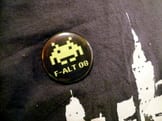I am at the Association for Learning Technology conference (ALT-C 2008) until Thursday. It’s the main UK conference for my area of work and the first time I have attended. I went to two pre-conference sessions today, as well as the F-ALT08 evening planning and discussion.
There’s a CrowdVine site for the conference, which is working very well to connect people both before and at the conference and the F-ALT08 wiki has been useful for pulling people together. I am proud to wear the official fringe badge.
This morning, I attended the Experiencing Mobile Learning and Assessment workshop at Leeds Metropolitan University. Three people spoke, really just introducing the themes for the afternoon sessions and giving a largely predicatable overview of the issues surrounding mobile learning and assessment. The afternoon sesssions looked good, but I left to attend the OpenSim, a pre-Second Life taster workshop. This was worthwhile as I’ve not really engaged with Second Life and we were able to trial some basic features of virtual worlds by using OpenSim running on the desktop machines rather than over the net. Using Second Life still doesn’t appeal to me personally, but I can see that it has some useful applications for role-playing different situations which are otherwise difficult to emulate in real life. I was mostly interested in OpenSim itself as an open source response to Linden Lab’s Second Life and will install it when I get back to work for other colleagues to test a Second Life-like environment prior to jumping into Second Life itself.
After registration and checking into the accomodation, I had some food and a wander around the sponsoring organisation’s stalls in the main hall. There were a couple of useful finds, notably that Learning Objects, Inc. are extending their wiki plugin, Teams LX, for use outside of the Blackboard VLE, basically providing a wiki-farm tool with fine access controls, including fully public. I’m currently on the look out for a wiki that’s as good as WordPressMU is for blogging. Confluence is currently my favourite, having used it extensively over the last few years. If anyone has any other suggestions, please let me know.
Finally, the F-ALT08 gathering in the student union bar was a decent way to end the day. Good to meet people, get a badge and talk loosely about the work we do. The session this evening was about Massive Open Online Courses (MOOCs), namely the Connectivism and Connective Knowledge course which started today with over 1600 registered ‘participants’.
Connectivism and Connective Knowledge is a twelve week course that will explore the concepts of connectivism and connective knowledge and explore their application as a framework for theories of teaching and learning. It will outline a connectivist understanding of educational systems of the future. This course will help participants make sense of the transformative impact of technology in teaching and learning over the last decade. The voices calling for reform do so from many perspectives, with some suggesting ‘new learners’ require different learning models, others suggesting reform is needed due to globalization and increased competition, and still others suggesting technology is the salvation for the shortfalls evident in the system today. While each of these views tell us about the need for change, they overlook the primary reasons why change is required.
Apparently only about 15 people are registered for credit. George Siemens, one of the two facilitators of the course is attending the conference, so I expect we’ll hear more about the MOOC over the next day or so. On the whole, most F-ALT attendees were sceptical about the value and longevity of MOOCs although I think it’s an interesting idea and hope it is a success, though how that is measured, I’m not sure. On an individual level, I think that with some effort, a lot could be gained from the 12 weeks of participation and reflective assignments. From my own experience of the Linux community over the last few years, I’m convinced of the benefits that can arise from participating in large, distributed, open and focused communities. Hopefully, these characteristics can also be developed in an educational context like the MOOC.
